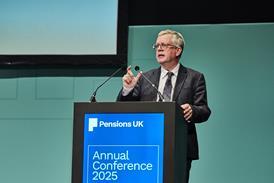The Pension Protection Fund will now require schemes to provide proof of the value of asset-backed contributions used to reduce levy bills, as part of the lifeboat's amendments to levy calculations.
The changes were as a result of the triennial consultation on levy rules, which ran from May to July of this year. It was also the first consultation since Experian was appointed as the insolvency risk provider.
David Taylor, director of strategy at the PPF, said the responses to the new model on the whole were positive, but there were some areas of concern.
One was the treatment of asset-backed contributions. According to the consultation response, the PPF will now consider all asset types, not just UK property.
Taylor said there had been concerns by both the PPF and the Pensions Regulator about some of these assets and the value attributed to them.
“[ABCs] come in lots of different guises and some of them are more likely to be valuable to us if a company were to go bust,” Taylor said.
Schemes with ABCs will need to certify some information for the PPF, and that information will be used over and above what is in the accounts, he added.
The changes were as a result of the triennial consultation on levy rules, which ran from May to July of this year. It was also the first consultation since Experian was appointed as the insolvency risk provider.
David Taylor, director of strategy at the PPF, said the responses to the new model on the whole were positive, but there were some areas of concern.
One was the treatment of asset-backed contributions. According to the consultation response, the PPF will now consider all asset types, not just UK property.
Taylor said there had been concerns by both the PPF and the Pensions Regulator about some of these assets and the value attributed to them.
“[ABCs] come in lots of different guises and some of them are more likely to be valuable to us if a company were to go bust,” Taylor said.
Schemes with ABCs will need to certify some information for the PPF, and that information will be used over and above what is in the accounts, he added.

Source: PPF consultation
Trustees will have to provide this certification by March 31 2015.
“So what that means, is if the asset is property and is readily usable by someone else, that valuation won’t look that different from the accounting valuation,” he said.
“But if the underlying asset is something that is more intangible, and something that is more tied up in the business of the company, then it may be harder to ascribe a higher value.”
Your company's mortgages
Further amendments include how the insolvency model takes into account mortgages and a revised approach to ABCs.
“The age of a company's most recent mortgage we know, in the aggregate, is a very good predictor of insolvency, so it is definitely something that should feature in a model like this,” Taylor said.
However, there are some circumstances in which a new mortgage is not a sign that something is going wrong.
“Examples of those would be where a company has existing secured financing, but for a positive reason wanted to refinance on terms that are good or better. In those circumstances, the fact that they had to regrant their mortgage shouldn’t result in a reduction of their insolvency score,” he said.
Transitional protection
According to the consultation, the move to Experian has increased the levy for some organisations. Although transitional protection was considered, it has now been rejected:

Source: PPF consultation
2015/16 consultation
In the consultation for the 2015/16 levy, released today, the pensions lifeboat will consult on whether small mortgages can be excluded from insolvency ratings. The new consultation will also look at the mechanics of the valuations of the ABCs.
Jim Bligh, the Confederation of British Industry’s head of pensions, said in a statement: “The PPF has made some much-needed and important changes to the way it calculates the levy, particularly in allowing greater flexibility for asset-backed contributions.
“Businesses are eager to see further changes to the model to ensure it is fair and accurately reflects their risk of insolvency. Large companies with overseas headquarters would be concerned if the PPF does not use a credit override.”














